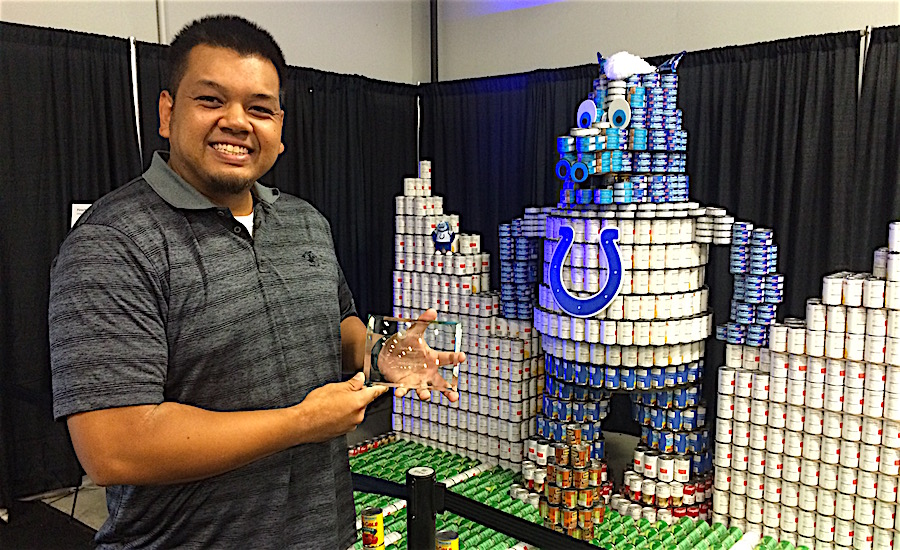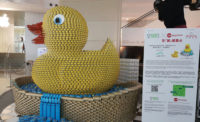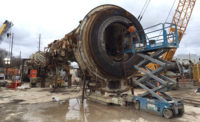INDIANAPOLIS—The massive hogs are getting noticed at this month’s Indiana State Fair but so is the annual "Canstruction" exhibition, where construction firms from all over the world spend countless hours designing and building large food-can sculptures, which are donated to local meal pantries.
“We had eight teams representing 12 AEC firms,” says Megan Scott, marketing manager for Indianapolis-based Schmidt Associates and one of the leaders of this local exhibit’s organizer, the Society for Marketing Professional Services. “The event has raised over 40,000 cans, which will be donated to Gleaners, providing over 24,000 meals to central Indiana families,” she adds.
A nonprofit organization based in Atlanta, Canstruction Inc. gives construction firms, schools and universities an opportunity to combat hunger by competing each year for the world’s top sculptures made completely out of canned foods. Since its founding in 1992, the program has grown from an operation in U.S., Canada and Mexico to spreading hunger relief for communities in South America, Europe, Australia and Asia. More than 150 cities worldwide now compete for international awards, according to Carrie Kirk, executive director of Canstruction Inc.
“One of our winners flew over from Hong Kong last year,” Kirk told ENR in a phone conversation, noting that construction teams involved in Hong Kong International Airport’s expansion submitted a giant Buddha head that appeared to be floating in the clouds.
The Buddha sculpture, which went on display at the American Institute of Architect’s annual meeting this past May in Philadelphia, won Canstruction’s 2015 Founder’s Award—named after the charity’s originator, Cheri Melillo, who created the organization nearly 25 years ago while working at the New York City-based Society for Design Administration. She died of brain cancer in 2009.
“That’s when we really re-birthed the company,” Kirk said. “We added junior, university and international divisions, and we added special events.”
Canstruction now receives submissions for city candidates through its website, which requires a $500 entry fee, and is accepting 2016 registrants through Dec. 31. While exhibits are open, local teams are eligible to receive awards at the city level. In the following year, the top global award winners are declared.
“Once we receive all the city-wide submittals globally, then we have another panel of international jurors,” Kirk says. “Last year, we had 16,000 structures competing.” ENR on Aug. 12 served as a judge for the Indianapolis Canstruction competition of eight sculptures—four of which received awards.
The winning teams in Indianapolis are InterDesign Architects, CE Solutions and Mattcon General Contractors; BSA LifeStructures, Hunt Construction Group and AECOM; Build Your Future Indiana and the Indiana Construction Roundtable; and grocery-store chain Kroger Co. Other candidates included CSO Architects and ERMCO Inc.; Ratio Architects and Turner Construction; Schmidt Associates and F.A. Wilhelm Construction; and arcDesign and Charles C. Brandt Construction.
Putting together the exhibits requires ample volunteer time and resources, boosters say. "SMPS spends a lot of time organizing the event, as do all the teams developing their concept and making it a reality," Scott explained.
How To Build Winning Cans
A few basic rules—structures must be self-supporting, adhesives are not allowed, and installations must take no more than 12 hours, to name a few—make competitions challenging for the firms involved. Judges also look at food labels to see if the positioning has merit and if meal combinations—tuna, chili beans and corn, for example—would be tasty to eat.
Custom sculptures for private and corporate events also are encouraged. Last month, Fiat Chrysler Automobiles built a life-size Jeep Wrangler out of 5,000 cans to celebrate Canada Day in Vancouver. In 2011, John Deere built a life-size S-series farm combine using more than 300,000 cans; the combine was displayed in downtown Moline, Ill. Later, the cans were donated to local food banks.
“We’re hoping to roll out some more guidance to the teams in their competition materials on how to make their structures look better,” Kirk said. “Some of our best designers in our New York City chapter are putting together how-to-make-cans-look-cool hints.”
Industry firms involved in the events already are cooking up modern construction technology, innovation and creativity into their exhibits.
“Every single level had its own Revit rendering,” says Chuck Penaflor, an estimator for Mattcon General Contractors, which one three awards at the Indiana fairgrounds for its exhibit of a life-size version of "Blue," the mascot for the Indianapolis Colts professional football team.
“The head was the most difficult part,” Penaflor says. “Getting that to not fall over was one of the more difficult things, but the Revit design was near perfect.”
The use of building information modeling kept Blue upright as it appeared to be kicking a pigskin over a field goal. Along with local design firm InterDesign Architects and structural engineer CE Solutions, Mattcon installed more than 3,100 food cans—or roughly 2,000 meals—for hungry Hoosiers.
At the global level, what makes a successful Canstruction sculpture a winner? Designs should be structurally challenging but also unique, said Kirk, who is a trained mechanical engineer.
“We want original things,” she explained. “We’re not looking for replicas of pop culture—such as Darth Vader and Hello Kitty.” Many times, however, those kind of statues are what the annual army of some 10,000 Canstruction volunteers end up building. Kirk said she hopes to help raise the profile of Canstruction's future so it can continue to increase its fight against global hunger.
“What we are really looking for is art,” Kirk said. “There is a fine line between structural integrity and art.”




